Table of Contents
Best Note Taking App on Windows: A Complete Guide for Productivity
Introduction
Staying organized can be difficult when juggling multiple projects, personal commitments, and daily tasks. Digital note-taking apps promise to simplify this, yet choosing the right one on Windows isn’t always straightforward. Having tested different options as a software engineer, I’ve seen how the right app can boost productivity at work and in life. Personally, Microsoft OneNote became my daily companion — from managing software projects, writing shopping lists, sketching application ideas, to keeping track of to-do lists.
We have already investigated PowerToys for Windows productivity and now It’s time to take a look at some other applications.
This guide breaks down the best note taking apps on Windows, their strengths, pricing, and suitability, so you can find the right fit for your workflow.
Why Note Taking Apps Matter on Windows
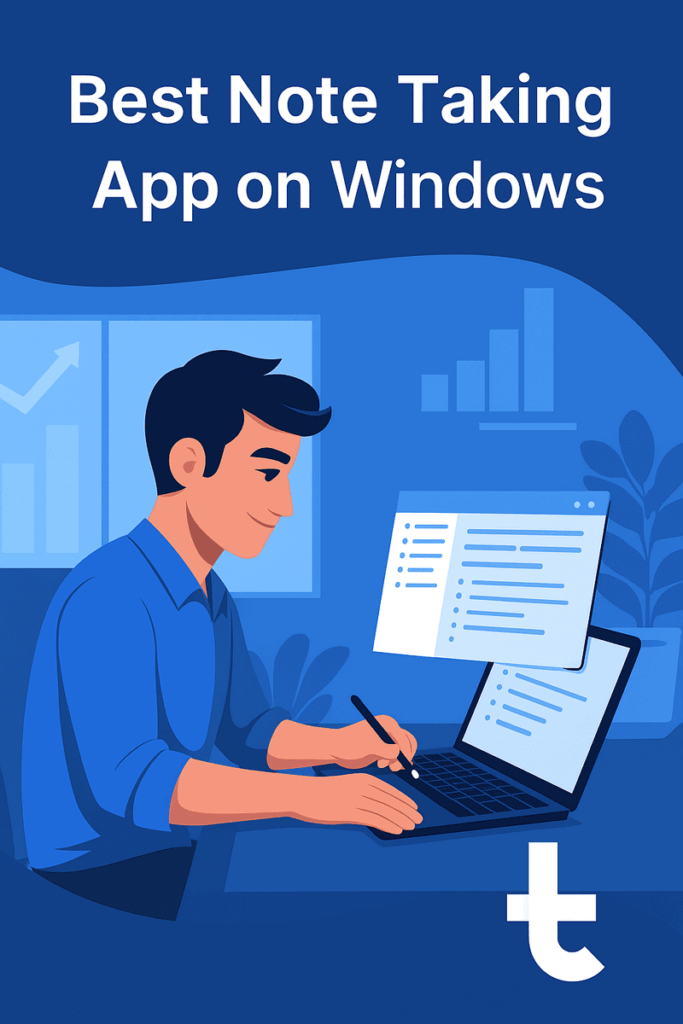
Windows remains the most widely used desktop operating system, and its flexibility attracts professionals, students, and everyday users. A good note-taking app on Windows should:
- Sync across devices (desktop, mobile, web)
- Support different input types (typed notes, handwriting, images, voice)
- Offer simple organization and search functions
- Provide reliable offline access
- Fit within your budget
Whether you need something lightweight or a full workspace tool, Windows has strong contenders.
Read More: Windows 10 End of Life Support
Microsoft OneNote: The Versatile Free Notebook
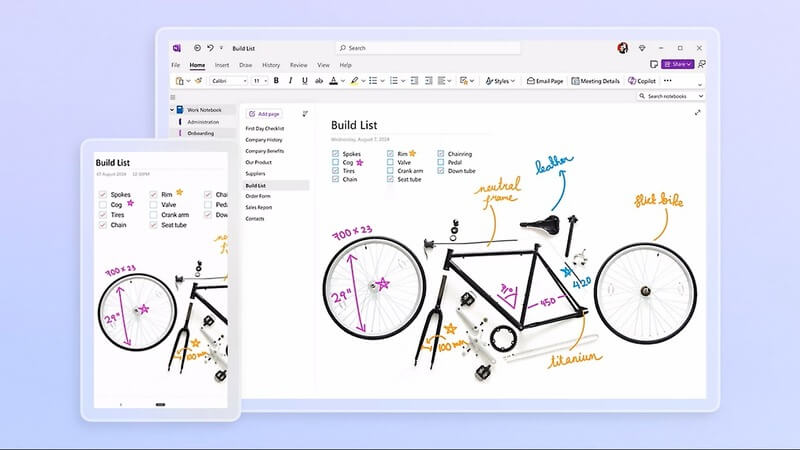
Microsoft OneNote is widely considered the best note taking app on Windows for its flexibility, strong Microsoft 365 integration, and pricing.
Key Features
- Freeform canvas for typed or handwritten notes
- Drawing support with pen and touch devices
- Math equation input and OCR for images
- Real-time synchronization via OneDrive
- Copilot AI assistance in premium versions
Pricing
- Free with 5GB OneDrive storage
- Microsoft 365 Personal: $6.99/month, Family: $9.99/month
- Business plans start from $6/user per month
My Experience Using OneNote
I first adopted OneNote while managing complex software projects. Its freeform pages allowed me to map out workflows visually, using drawings and sticky-style notes. At home, I built separate sections for groceries, to-do lists, and even app ideas. This flexibility meant I wasn’t locked into one structure — I could brainstorm freely yet return later to organize.
For me, OneNote stood out because it handled both casual personal notes and structured professional planning within the same app.
OneNote User Reviews Summary
Overall Ratings
- On SoftwareAdvice, OneNote holds an overall rating of 4.6 out of 5, scoring highly for ease of use (4.6), value (4.6), and functionality (4.5)
- SelectHub shows a strong 91% user satisfaction based on over 2,700 reviews.
Strengths Reported by Users
- Flexible organization: Users appreciate OneNote’s notebook-section-page structure for managing ideas and projects.
- Seamless sync & accessibility: Sync across devices (desktop, mobile, web) earns praise for convenience.
- Rich multimedia support: The app handles typed text, handwriting, audio, images, diagrams—valuable for varied note types.
- Microsoft integration: Tight integration with Office 365, Outlook, Teams, and OneDrive is a standout feature.
- Collaboration features: Real-time co-editing and shared notebooks are popular among teams and students.
Common Complaints
- Sync and performance issues: Many users report syncing delays, failures, or inconsistent behavior across devices.
- Lag and crashes: Reports of slow load times, freezing, and occasional crashes, especially in large notebooks or on lower-end devices.
- UI feels dated or cluttered: Some find the interface overly busy or outdated in design.
- Feature gaps across platforms: Disparities exist between desktop, mobile, and web versions—leading to frustration over missing features.
- Limited formatting/export options: Users note weak formatting tools (e.g. tables, fonts) and limited export paths to other formats.
- Task integration lacks polish: Integration with Microsoft To Do feels clunky or incomplete—one user described adding tasks via flagged notes as awkward.
Direct User Voices
“Syncing crossed platforms … cannot be trusted … those changes take slightly longer to sync across platforms.” (Reddit)
“Despite its many features … syncing is dismal; slow loading, poor UX.” (Reddit)
“Lack of proper integration with Microsoft To Do … The worst possible way to create a task.” (Reddit)
“Interface is awful … scroll speed is inconsistent and slow … content wrappers feel weird.” (Reddit)
Summary at a Glance
| Strengths | Common Drawbacks |
|---|---|
| Intuitive notebook structure and rich media support | Sync hiccups, slow loading, crash risks |
| Seamless Microsoft ecosystem integration | Dated or cluttered design |
| Cross-device access and real-time collaboration | Limited formatting/export and task tools |
Bottom line: OneNote shines with its organizational flexibility, rich media handling, and deep Microsoft integration. However, inconsistent syncing, interface bloat, and platform disparities are notable drawbacks. Best suited for users deeply embedded in the Microsoft ecosystem who value multimedia and collaboration—but power users may run into frustrations around performance and workflow gaps.
Notion: Customizable Workspace
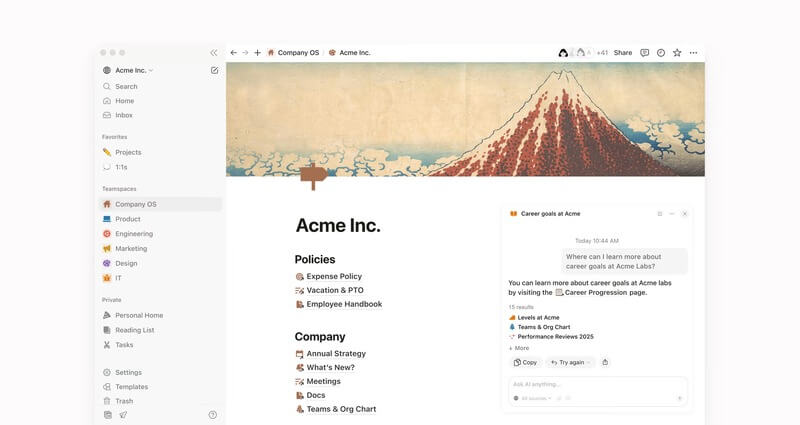
Notion has grown into a favorite for teams and individuals who want a highly structured note-taking environment. It is one of the most strong contenders as note taking software for Windows.
Key Features
- Block-based editor for text, images, and databases
- Kanban boards, calendars, and templates
- Advanced collaboration with permissions
- API integrations and AI writing support
Pricing
- Free plan with limited features and 10 guests
- Plus plan: $10/month annually
- Business: $15/month annually
- Enterprise: Custom pricing
Who Should Use Notion?
Notion is ideal for users who want project management and note-taking combined. If you’re building a startup, working with a distributed team, or enjoy detailed customization, Notion gives you that structure. On the downside, its mobile app can feel restrictive compared to the Windows desktop experience.
Notion User Reviews Summary
Overall Ratings
- On SoftwareAdvice, Notion has a strong average rating of 4.7 out of 5, with high scores in value for money (4.6) and functionality (4.6).
- Trustpilot, however, shows a TrustScore of 2.4/5, with many users citing issues around billing, refunds, and customer service.
Common Strengths
- Customization and flexibility: Users praise Notion’s modular building blocks and templates. One called it a “second brain” for organizing both personal and work life.
- Versatile workspace: G2 users report replacing multiple scattered tools—docs, wikis, task trackers—with a central hub in Notion. Dashboards for projects, notes, OKRs, and knowledge bases improved collaboration.
- Visual organization: Board, table, list, calendar, and timeline views make tracking flexible projects easier..
- Cross-platform availability: Consistent experience across desktop, mobile, and web—plus an intuitive layout with a clean sidebar—garners praise.
- Free plan value: Many appreciate the comprehensive free tier with most features available.
- Helpful support resources: Users rely on Notion’s help center, tutorials, structured lessons, and Notion Academy to ramp up.
Common Complaints
- Steep learning curve: Some users find Notion overwhelming at first. Building workflows takes time, and new users can get bogged down.
- Performance drag: Notion can be slow to load, especially with large databases or complex pages on mid-tier devices.
- Limited features in certain areas: Compared to specialized tools, some features like Gantt charts or resource management feel superficial.
- Mobile and Android issues: The Android app is noted as sluggish and feature-lacking; mobile usability draws mixed feedback.
- Support and billing frustrations: Notion’s billing practices and customer service receive harsh criticism. Complaints about being charged after downgrades or poor support resolution are common.
- Missing functionality users request: On Reddit, users ask for native email linking, better reminders, improved offline mode, granular permissions, and other usability improvements.
User Voices
“It’s been great… Notion really is like a second brain for me.” — Web Designer on Capterra (Capterra)
“We were able to replace scattered docs, task trackers, and wikis with one central hub… relational databases and templates save us hours every week.”
“Notion’s pro and team is quite overpriced as compared to its features… Subscription is a bit expensive.”
“I have build some processes in notion with AI functions… contacted customer service… nothing happened. They keep charging.”
“Offline mode… for many of us, it’s a crucial functionality… instead, Notion seems more interested in developing flashy new features.”
Overview Table
| Strengths | Drawbacks |
|---|---|
| Highly customizable workspace | Steep learning curve |
| Flexible views & modular layout | Performance lags on complex content |
| All-in-one hub replaces many apps | Mobile/Android usability issues |
| Solid free tier & rich templates | Billing and customer support complaints |
| Robust help resources | Missing key requested features |
Bottom line: Notion earns praise for its adaptability, clean interface, and ability to unite documentation, project tracking, and planning under one roof. It’s particularly valued by users who enjoy building customized workflows. However, newcomers may feel intimidated, performance slows with scale, mobile support lags, and billing/support inconsistencies erode trust.
ClickUp: Notes + Project Management

ClickUp started as a project management platform but has evolved into an all-in-one productivity suite. You have seen their ads on YouTube. They placed themselves as the best note taking app n Windows. Let’s see if that is true.
Key Features
- Task and note integration
- Multiple views: List, Board, Calendar, Gantt
- Custom templates and fields
- Time tracking and automation
- AI writing assistance (add-on)
Pricing
- Free plan with 100MB storage
- Unlimited plan: $7/month annually
- Business plan: $12/month annually
Best For
ClickUp suits professionals who want to combine note-taking with full project management. It might feel too heavy for personal notes, but for teams running projects, it replaces multiple apps.
ClickUp User Reviews Summary
Overall Impressions
- Reviewers note ClickUp offers a fairly comprehensive free plan, including unlimited tasks, docs, integrations, and various project views—making it appealing to freelancers and smaller teams.
- According to KDnuggets, it’s recognized as an all-in-one productivity platform offering task management, collaboration tools, and automation at competitive pricing.
Highlights (Pros)
- Custom workflow flexibility: Users can design tasks, statuses, dashboards, and automation that fit workflows precisely—e.g. Agile sprints or to-do lists.
- Multiple project views: Switch easily between List, Board, Gantt, Calendar, Timeline, even Mind Map views.
- Strong collaboration tools: Real-time editing, whiteboards, comments, chats, time tracking, reporting—organized in one hub.
- Automation capabilities: Automate task assignments, status changes, reminders, and more with built-in rules.
- Generous free tier: Includes keys like dashboards and integrations without paying.
Common Drawbacks (Cons)
- Learning curve: New users often feel overwhelmed. Customization comes at the cost of time spent learning the platform.
- Performance issues: Reports of lag, slow load times, glitches—especially with large files or complex workflows.
- Overwhelming for small teams: Some feel the feature set is more than necessary for simpler use cases.
- Mobile limitations: Mobile apps can feel sluggish, unintuitive, or missing features present on desktop.
Real User Voices (Reddit Highlights)
“ClickUp promises a powerful project management solution … but in reality, it’s a confusing mess. From its cluttered interface to slow automations…”
— Reddit review pointing out interface clutter and slowdowns (Reddit)
“Support is unhelpful. … Buggy and slow UI … Billing is a joke.”
— Enterprise user warning against poor support and UI (Reddit)
“Lag is real… it’s so slow compared to Trello and Asana.”
— User frustrated by slow responsiveness (Reddit)
“Limited offline use… it’s not really an app, just a thin veneer over their website.”
— Concern over offline reliability and infrastructure design (Reddit)
“They changed prices, and our bill went 10x with no previous notice… data deleted after 90 days inactivity.”
— Harsh critique on billing practices and data handling (Reddit)
Summary Table
| Strengths | Challenges & Drawbacks |
|---|---|
| Highly customizable workflows | Steep learning curve |
| Multiple views (List, Board, Gantt) | Performance issues in complex usage |
| Built-in automation, docs, time tracking | Overkill for simpler projects |
| Strong free version | Mobile and offline limitations |
| Unified workspace for collaboration | Reported billing, support, and UI issues |
Bottom line: ClickUp packs powerful features—offering deep customization, varied project views, task automation, and all-in-one collaboration. It’s well-suited for teams that need that level of control and functionality. But users should expect a noticeable learning period, potentially sluggish performance, and be cautious about mobile limitations and customer service or billing concerns.
Evernote: Once the Leader, Now Struggling
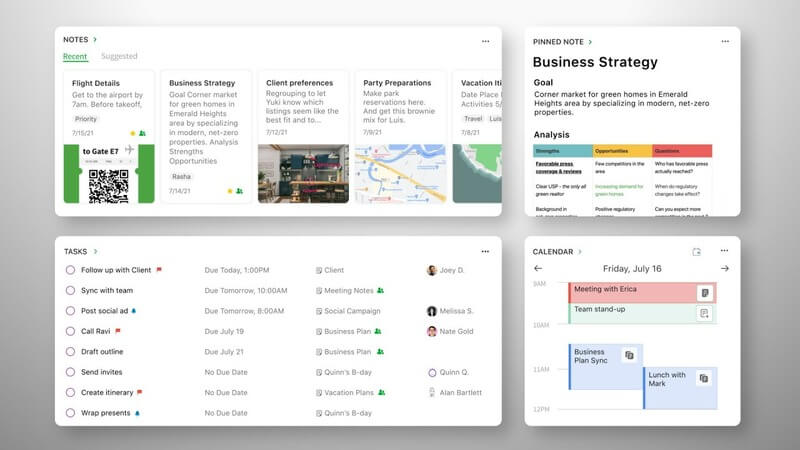
Evernote pioneered digital note-taking but has lost ground due to pricing changes and feature restrictions. Imagine being the best note taking app on Windows just so that your direct competitors take that title from you. But, never the less this is still an awesome option as a digital notebook for Windows.
Key Features
- Web clipper and document scanning
- PDF annotation and calendar integration
- OCR search in images and documents
Pricing
- Free: Very limited (50 notes, 2 devices, 250MB monthly uploads)
- Personal: $14.99/month
- Professional: $17.99/month
- Teams: $24.99/user/month
Verdict
Evernote remains strong in search and organization, but the steep pricing makes it less attractive compared to free or cheaper alternatives.
Evernote User Reviews Summary
Overall Impressions
- TechRepublic praises Evernote’s user experience as excellent, rating it 5 out of 5 for ease of use, organization, search, and sync.
- SelectHub highlights Evernote’s robust features: tags, notebooks, stacks, web clipping, multimedia support, templates, offline access, integrations, and strong security.
Pros (What Users Appreciate)
- Strong organization tools: Users can structure notes via notebooks, stacks, tags, and templates for efficient management.
- Advanced search & OCR: Search within text and images—handwritten or scanned—is fast and powerful.
- Web Clipper & scanning: Easily save web pages or physical documents using the Web Clipper or document scanner.
- Cross-platform support: Available on desktop, mobile, and web, with cloud sync and offline access.
- Templates & workflows: Built-in templates and checklists help users start faster and stay organized.
- Dashboard & AI tools: Paid tiers include customizable home dashboards and AI features like cleanup and summarization.
Drawbacks (Common Frustrations)
- Paid plans are pricey: Users feel the cost is steep compared to competitors, with many advanced features locked behind paywalls.
- Free tier limitations: The free version restricts uploads, device sync, notebooks, and offline access—making it feel more like a trial.
- Sync & performance bugs: Reports include slow performance, syncing failures, crashes, and even data loss.
- Unresponsive customer support: Many users report delayed or unhelpful support, and difficulty resolving account or technical issues.
- UI overload and instability: The interface feels cluttered to some, with frequent feature changes that disrupt workflows.
Voices from Users
“I lose 10–20 minutes just for it to launch … I’m premium … but it’s just trash, heavy, slow and failing to sync.” (Reddit)
“I’m done with Evernote … ‘Syncing temporarily paused’ error held on for two weeks.” (Reddit)
“Customer service is the worst … it took four days to respond, and they couldn’t solve anything.” (Reddit)
“For long-time users: price increases, poor support, and broken promises broke my loyalty.” (Reddit)
“So many features exist—but they’re incomplete. I feel excited at announcements—then disappointed when they don’t work reliably.” (Reddit)
“After 14 years of using Evernote, the recent updates made me come back—especially for its PDF tools, calendared tasks, and slash commands.” (Reddit)
Summary Table
| Strengths | Limitations & Issues |
|---|---|
| Rich organization tools & search | High subscription cost |
| Web Clipper and document scanning | Free tier is very restrictive |
| Cross-device sync and offline access | Sync lag, crashes, and instability |
| Templates, dashboards, AI features | Support is slow or unhelpful |
| Wide platform coverage | UI feels bloated and inconsistency in features |
Bottom line: Evernote remains a powerful, feature-rich note-taking tool—especially strong in organization, searching, and content capture. It’s ideal for heavy users who need advanced tools. But its high cost, sync reliability issues, and support frustrations make it less appealing to casual users or those prioritizing simplicity and dependability.
Simplenote: Distraction-Free Writing
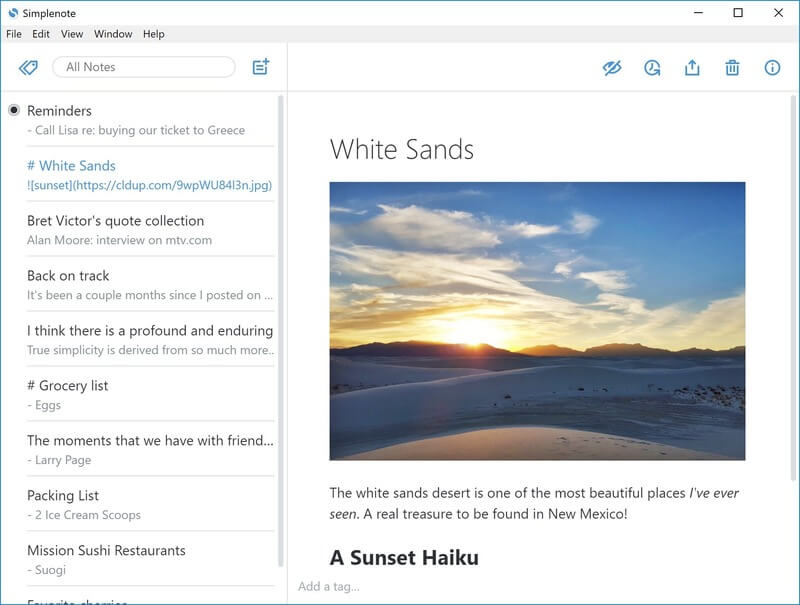
Simplenote is perfect if you want a minimalist, text-first note-taking app.
Features
- Markdown support
- Unlimited notes and version history
- Tag-based organization
- Real-time sync across devices
Pricing
- Completely free
- Optional “Sustainer” plan at $19.99/month or $199.99/year (no extra features, just supports development)
Simplenote shines when all you need is a clean, fast note-taking tool without extras.
Simplenote User Reviews Summary
Overall Reputation
- TechRadar describes Simplenote as offering a very user-friendly interface, completely free, but lacking advanced features in comparison to competitors.
- Productivity.Directory highlights Simplenote’s minimalist design, seamless cross-platform syncing, Markdown support, and intuitive experience—emphasizing its appeal for quick, clean, text-based note-taking.
Pros (What Users Like)
- Clean, distraction-free interface: Many users appreciate Simplenote’s simple layout that lets them focus on writing without extra clutter.
- Cross-platform accessibility: Available on Windows, macOS, Linux, iOS, Android, and web, with reliable syncing across devices.
- Markdown formatting and version history: Offers Markdown support and the ability to view earlier versions of notes.
- Completely free with no ads: All core features are available for free, with no ads or premium tier locking users out.
- Public sharing and syncing speed: Users enjoy features like publishing notes via public links and fast auto-sync.
Cons (Common Frustrations)
- Lacks advanced features: No support for media attachments, rich text formatting, notebooks, or folders.
- Sync and reliability issues: Reports of syncing problems and server downtimes have emerged.
- Security and privacy concerns: Multiple users experienced serious issues such as seeing others’ notes and accidental data breaches.
- Limited formatting features: Advanced Markdown editing lacks real-time preview, and the UI remains plain; no spellcheck in Windows or web versions.
- Basic tagging and search limitations: The search function doesn’t interact with tags, inability to apply tags in bulk, and limited data export.
Real User Feedback (Reddit Highlights)
“Used it for a bit … then one day my notes were all gone and someone else’s notes were there. Deleted my account immediately.”
“I’ve used Simplenote since 2015 … but twice in the past month, content I’d written synced into the wrong note. Not confident anymore.”
“In the last week … constant instances of it not connecting to the server for HOURS … genuinely messing with my work.”
Summary Table
| Strengths | Limitations & Risks |
|---|---|
| Minimalistic, focused interface | No media or rich formatting support |
| Strong cross-device accessibility | Sync reliability and server downtime issues |
| Markdown + version history | Security lapses and data exposure incidents |
| Fully free, no ads or hidden tiers | Limited tagging, search, export, and formatting features |
Bottom line: Simplenote is a compelling choice for users seeking a distraction-free, text-first note-taking experience: clean UI, Markdown support, and seamless syncing across platforms—all at zero cost. However, those who need media support, robust formatting, reliable syncing, or strong security may find its limitations too restrictive.
Sticky Notes: Quick and Informal Notes
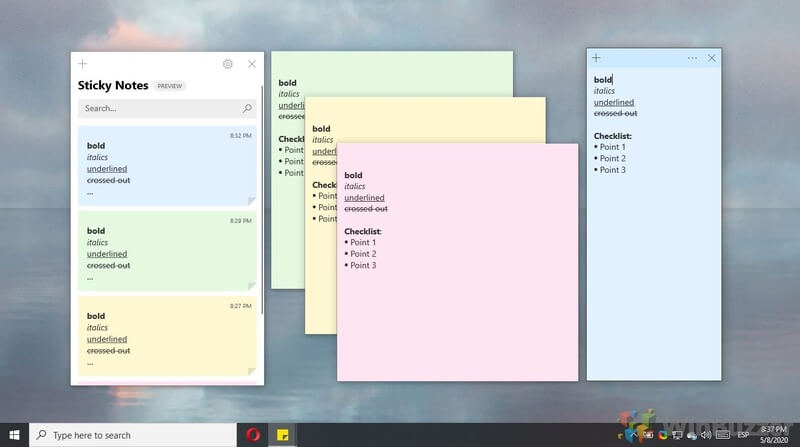
Microsoft Sticky Notes evolved from a basic desktop utility into a cloud-synced note tool.
Features
- Color coding and text formatting
- Handwriting support on touch devices
- Sync via OneNote mobile app
Pricing
- Completely free with OneDrive storage
Sticky Notes is best for quick reminders rather than detailed note-taking.
Microsoft Sticky Notes User Reviews Summary
Overall Perspective
Sticky Notes is a long-standing Windows staple, valued for its simplicity and speed. It has evolved from a basic post-it equivalent into a UWP app integrated with Microsoft cloud services and OneNote for syncing across devices.
What Users Like (Pros)
- Quick and visible reminders
Users appreciate having persistent visual cues on their desktop—sticky notes stay in view, gently reminding without pushing alerts. - Seamless OneNote integration
Notes can sync with OneNote mobile, helping bridge desktop and mobile workflows. - Simple, approachable interface
The app is easy to use and free of complexity—great for jotting down quick thoughts or to-dos. - Customization options
Users can personalize note colors, and use basic text formatting; it even integrates with Cortana for reminders.
What Users Criticize (Cons)
- Sync issues and data loss
Many report notes disappearing or failing to sync correctly after updates, with no simple way to recover them. - Laggy and clunky interface
Scrolling and interaction in the newest versions are reported as janky or slow—hurting the seamless experience users expect. - Lost simplicity
The shift toward OneNote-centric design has removed key comforts like freely draggable/resizable notes, making quick jotting feel more cumbersome. - Cluttered desktop space
Without an option to collapse or hide notes, managing many sticky notes can overwhelm the screen and slow workflows. - Bugs and crashes
Users describe unstable behaviors: notes crashing, duplicating when reopening, freezing, or becoming unresponsive.
Voices from the Community
“Sticky notes drop half my notes after an update… no recovery.” — reported frustration with syncing pains.
“The new interface is more minimal, but I miss dragging notes freely—it now feels rigid and impractical.”
“Whenever I open Sticky Notes, ALL notes open at once, slowing my system to a crawl.”
“App randomly crashes or opens duplicates… loses cursor control or text selection—annoying and unpredictable.”
Quick Summary Table
| Strengths | Limitations & Frustrations |
|---|---|
| Fast, lightweight note-taking tool | Sync failures, sometimes data loss |
| Desktop visibility for reminders | Laggy interface, poor scrolling performance |
| Easy to use and customize | Lost simple functions like resizing or dragging |
| OneNote integration across devices | No way to collapse notes; screen clutter grows |
| Cortana reminders and color notes | Crashes, bugs, and duplicate note behavior |
Bottom Line: Sticky Notes remains a convenient, minimalist helper—great when you need a quick reminder or simple note on your desktop. But recent updates shifted its identity, introducing syncing troubles, interface lag, and the loss of long-loved features. Users wanting fluid, reliable note-taking—especially across devices—may need to consider alternatives or stick with classic versions.
Scrble: For Windows Tablet Users
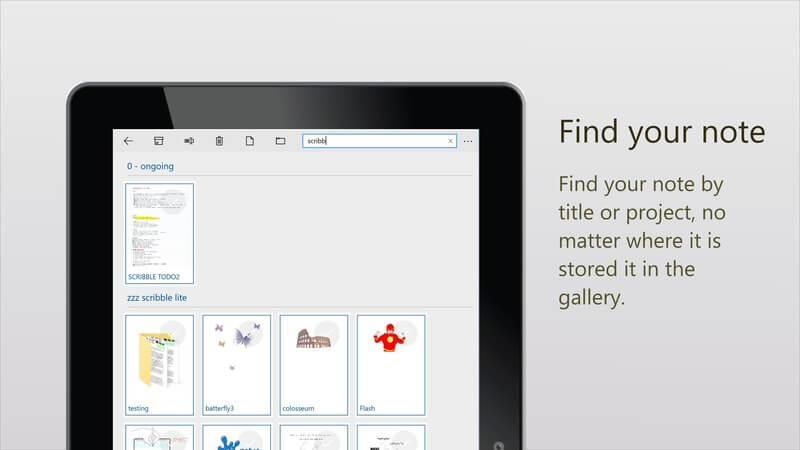
Scrble is specialized for freehand writing on touch-enabled Windows tablets.
Features
- Infinite canvas for handwriting
- Shape recognition and PDF annotation
- Multiple paper backgrounds
Pricing
- One-time purchase: $3.99–$6.99
- No subscription required
Best for students or creatives who prefer digital ink over typing.
Comparison Table
| App | Pricing | Strengths | Limitations |
|---|---|---|---|
| OneNote | Free / $6.99+ | Flexible, cross-platform, strong MS 365 | UI can feel cluttered |
| Notion | Free / $10–15 | Customizable, collaboration, databases | Mobile experience weaker |
| ClickUp | Free / $7–12 | Project + notes, automation | Complex for simple use |
| Evernote | $14.99–24.99 | Powerful search, web clipper | Pricey, limited free tier |
| Simplenote | Free | Minimalist, markdown, fast | No advanced features |
| StickyNotes | Free | Quick reminders, handwriting support | Basic functionality |
| Scrble | $3.99–6.99 (one-time) | Handwriting-focused, infinite canvas | Windows only, no sync |
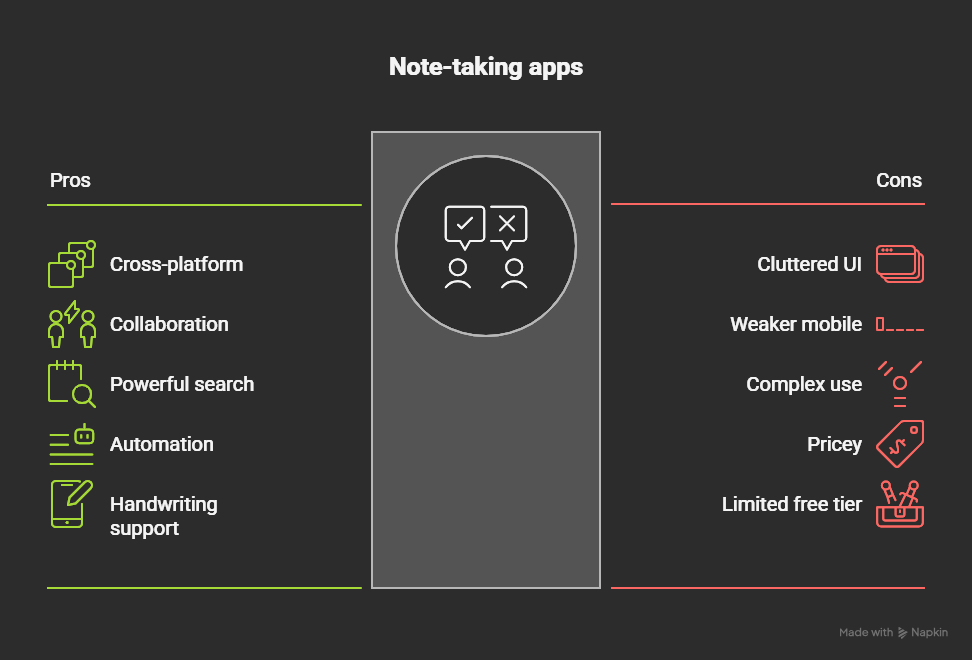
Final Thoughts
Choosing the best note taking app on Windows depends on your goals:
- For all-around flexibility → OneNote
- For structured projects → Notion
- For integrated task management → ClickUp
- For text-focused simplicity → Simplenote
- For handwritten notes → Scrble
In my own experience, OneNote remains the most practical choice. It allows me to run my work projects, draft code ideas, and keep household reminders all in one place. If you want an app that adapts to both personal and professional life, OneNote is the most balanced option.







